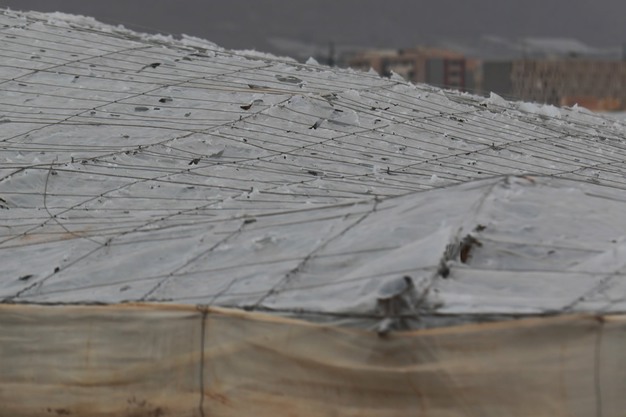Jan van der Blom, who works for the Spanish cooperative Coexphal, lives only 20 kilometres away from the horticultural area of El Ejido. In his hometown it had only rained a little, however, when he visited the horticultural area hit by severe weather on Tuesday, he saw quite a few greenhouses affected by the hail damage. "At the same time, it remains mainly a local matter. I expect the impact on the overall crop to be limited."

"An estimated 90 hectares of greenhouses succumbed to the hail. For those horticulturists, this is of course a big noose, but it is only a small percentage of the approximately 33,000 hectares of cultivation in Almería. Moreover, these are always old flat greenhouses. Other greenhouses, with a sloping roof structure can handle this weight. There are quite a few greenhouses in which the hail has smashed right through the plastic, especially those where the plastic was almost due for replacement. In greenhouses with newer plastic, you do sometimes see smaller holes. Many car windows and solar panels were also smashed by hailstones the size of ping-pong balls. By the way, in the affected area I also see many greenhouses with absolutely nothing to see," Jan says.

"I heard that the mayor spoke of an area of 4,500 hectares that suffered damage, but that seems to me to be a gross exaggeration. The total damage is still hard to see. Tomatoes are grown very little in the area in question, so they have not suffered at all. So it is pepper, cucumber and aubergine. I don't believe it's about the 20% pepper mentioned, because ultimately only a limited area has been affected. But it is too early to take stock yet."

"Fortunately in Almería there were no personal accidents, the hail fell in the evening when nobody was working in the greenhouses. So in that respect it is much worse in some villages in Valencia, where so much rain fell in a short time that people were swallowed by a swirling stream," Jan continued.

"The crops are just at the beginning here in Almería. The pepper crops are slowly coming on stream. These were planted a bit later and August, with high temperatures and dry winds, was a pretty problematic month for fruiting. You can still notice this now, which meant that supply was at a lower level. Meanwhile, some larger volumes are coming onto the market," says Jan, who has now lived and worked in Spain for more than 30 years.

In Spanish tomato cultivation, Van der Blom does not see that many changes compared to last year. "Growers are still apprehensive about the ToBRFV virus, but are not as scared as last year. There are also quite a few varieties that have high resistance. We do see that since last year there have been more trip problems, especially in peppers. The necessary bugs have now been released for this, because by now it has become clear that chemical control is an unholy road."
 For more information:
For more information:
Jan van der Blom
Coexphal
Dpto. Técnicas de Producción
c/ Esteban Murillo, 3,
04746 El Viso, Almería
Tel: (+34) 950 558230
Móvil: (+34) 609 571802
jvdblom@coexphal.es
www.coexphal.es
